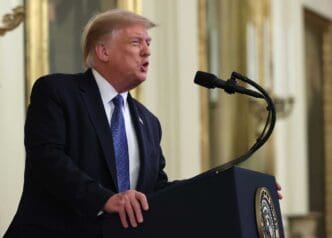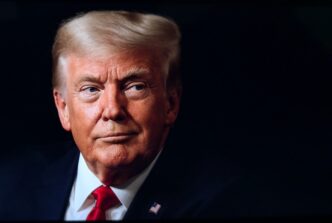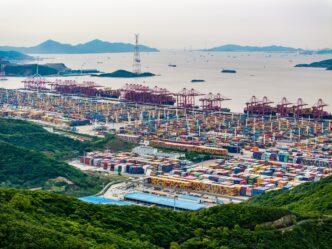For the first time in decades, the American economy is staring into the abyss of stagflation—a toxic cocktail of rising unemployment and rising prices that crippled the nation in the 1970s. The latest jobs report is not just a warning sign; it is a blaring alarm bell, revealing the profound and predictable damage that President Donald Trump’s chaotic economic policies are inflicting on American workers and businesses.
The numbers are an unmitigated disaster. The Bureau of Labor Statistics (BLS), the nonpartisan federal agency responsible for tracking our labor market, reported that the U.S. economy created a pathetic 73,000 jobs in July. To make matters worse, the agency’s downward revisions for the prior two months paint an even grimmer picture, with the economy now averaging a paltry 35,000 new jobs a month over the last quarter. This is the worst three-month period in a decade, outside of the 2020 pandemic shutdown.
An economy treading water needs to create at least 80,000 to 100,000 jobs a month just to keep up with population growth. The current numbers are a recipe for recession. The national unemployment rate has ticked up to nearly 4.3%, and the pain is not being felt equally. The unemployment rate for Black workers has shot up to a recessionary level of 7.2%, the worst since October 2021. Despite the president’s hollow promises to bring manufacturing back, the sector has now lost jobs for three straight months, shedding 173,000 jobs since its recent peak.
This bleak reality stands in stark contrast to the triumphant fantasy being peddled by the White House. Just last month, a press release declared that “President Trump is overseeing another economic boom.” This is not just spin; it is a dangerous detachment from the reality that millions of American families are now facing.
The president’s immediate response to this inconvenient truth was as predictable as it is alarming: he fired the director of the Bureau of Labor Statistics. This is not the action of a leader grappling with a complex problem; it is the knee-jerk reaction of an authoritarian lashing out at a messenger who dared to deliver bad news. It is part of a disturbing pattern of denying data and making up his own facts, a strategy he has already employed to eliminate statistics on climate change and infectious diseases that contradict his political narrative.
The deteriorating job market is not a mystery; it is the direct and foreseeable result of this administration’s reckless economic policies. The widespread and erratic use of historically high tariffs has created a fog of uncertainty, causing a catastrophic loss of business confidence that has led owners to slam the brakes on investment and hiring.
Furthermore, the tariffs are a self-inflicted wound on our own manufacturing base. Since many U.S. manufacturers rely on imported parts, the administration’s effective tariff rate of nearly 18% is a direct tax on American industry. Ford, which makes more cars in the U.S. than any other automaker, recently cited an $800 million hit from the tariffs as the cause of its first quarterly loss in years, a devastating blow to its “made in America” strategy.
At the same time, the administration’s cruel war on immigrants is actively shrinking our labor supply. The nonpartisan Congressional Budget Office has stated that immigration is a powerful engine for economic growth, projected to bolster the U.S. economy by $7 trillion over the next decade. Yet, this administration is actively deporting the very workers that our nation’s farms, construction sites, and hospitality businesses desperately rely on. This, combined with the administration’s assault on the federal workforce, which shed another 12,000 jobs in July, is actively contracting our economy.
The human cost of this policy failure is immense. The number of Americans unemployed for 27 weeks or longer has surged, reflecting a deep reluctance among companies to hire. This leads to suppressed wages, declining demand for goods and services, and a strain on the retirement funds of millions.
Normally, the Federal Reserve would respond to such a weak labor market by cutting interest rates to stimulate the economy. But its hands are tied. Because the president’s tariffs are simultaneously threatening to reignite inflation, the Fed is wisely holding rates steady, leaving us in the worst of both worlds.
The Florida Impact: A Sunshine State Under Storm Clouds
Nowhere are the risks of this impending stagflation more acute than in Florida. The state’s unique economic structure makes it particularly vulnerable to the fallout from the administration’s policies.
Florida’s economy runs on tourism and hospitality. A national slowdown, where families have less discretionary income and are less confident about the future, means fewer vacations. Fewer tourists mean fewer jobs in hotels, restaurants, theme parks, and cruise lines—the very backbone of the state’s workforce.
Furthermore, the administration’s anti-immigrant policies pose a direct threat to two of Florida’s most vital industries: construction and agriculture. The state’s booming real estate market and its agricultural heartland are powered by immigrant labor. A shrinking labor supply will inevitably lead to higher costs, project delays, and increased prices for consumers, threatening to cool the construction boom and harm the state’s farmers.
Finally, Florida is a global hub for international trade, particularly with Latin America. The administration’s erratic tariff policies create profound uncertainty for the state’s ports and logistics companies. And for Florida’s massive population of retirees, the specter of stagflation is a nightmare scenario. They rely on stable prices for their daily needs and the steady performance of their retirement funds to survive. A period of rising prices and a tanking stock market would be a devastating blow to their financial security.
The question now is whether the president will listen to the clear signals the market is sending and reverse course on his destructive economic policies. His decision to fire the BLS Commissioner, however, suggests a doubling down on denial.








